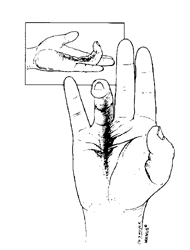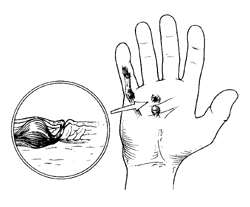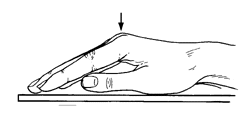What is it?
Dupuytren’s disease is an abnormal thickening of the fascia (the tissue between the skin and the tendons in the palm) that may limit movement of one or more fingers. In some patients, a cord forms beneath the skin that stretches from the palm into the fingers. The cord can cause the fingers to bend into the palm so they cannot be fully straightened (see Diagram 1). Sometimes, the disease will cause thickening over the knuckles of the finger. It can also occur in the soles of the feet.
What causes it?
The cause of Dupuytren’s is unknown and there is no permanent cure. The disease is usually painless. This is a non-cancerous condition. Dupuytren’s disease mostly affects white people with ancestors from Northern Europe. It occurs more often in men than in women, and usually starts after age 40. In many cases, the disease runs in families.
Some people may develop a more severe form of Dupuytren’s disease. These may be people who:
develop the disease at a young age
have the disease in areas other than the hand
Injuries to the hand have not been directly linked to causing the disease.
Signs and symptoms
Dupuytren’s disease occurs slowly. It is usually noticed as a small lump or pit in the palm. This tends to occur near the crease of the hand that is closest to the base of the ring and little fingers (see Diagram 2). With time, a cord may develop between the palm and the fingers.
The disease is usually noticed when the palm cannot be placed flat on an even surface, such as a table top (see Diagram 3). In severe cases, drawing of the fingers into the palm interferes with everyday activities, like washing hands, wearing gloves, and putting hands in pockets.
How does the disease develop?
The disease most often begins in the palm of the hand at the base of the ring or little fingers. A lump or pit may show up months or even years before a cord develops from the palm to the fingers. Drawing of the fingers into the hand can occur because of contracture of the fascia near the joints in the fingers. The skin may be involved with the disease, but the tendons in the hand are not affected. Having the disease in both hands is common.
Treatment
There is no permanent cure for Dupuytren’s disease. Surgery can relieve the bending of the fingers into the palm, but the condition can return with time. The goal of surgery for Dupuytren’s disease is to restore the use of the fingers. Your doctor should advise you on whether surgery is recommended in your case.
Some considerations on surgery:
Presence of the lump in the hand does not mean that surgery is required. Bending of the fingers into the palm at the base of the fingers is usually correctable by surgery. Surgery may not completely relieve bending of the fingers at the joints in the fingers.
It is important to remember that surgery is not a permanent cure for this disease. After surgery, thickening of the palm and development of the cord may return in the same place, or at a new place within the hand. Sometimes skin grafts are needed to cover open areas in the fingers. Sometimes splints are used after surgery to help keep the fingers straight. A hand therapist may help with your postoperative care to help control swelling and to help with finger motion.
Diagram 1
In serious cases of Dupuytren’s disease, a cord forms beneath the skin that prevents the affected finger from being fully straightened.
Diagram 2
Dupuytren’s disease usually shows up as a small lump or pit in the palm of the hand.
Diagram 3
Dupuytren’s disease is usually noticed when the palm cannot be placed flat on an even surface.
Diagram 4
Diagrams for doctor’s use.
Copyright © American Society for Surgery of the Hand.
All content copied with permission from ASSH (www.assh.org).




